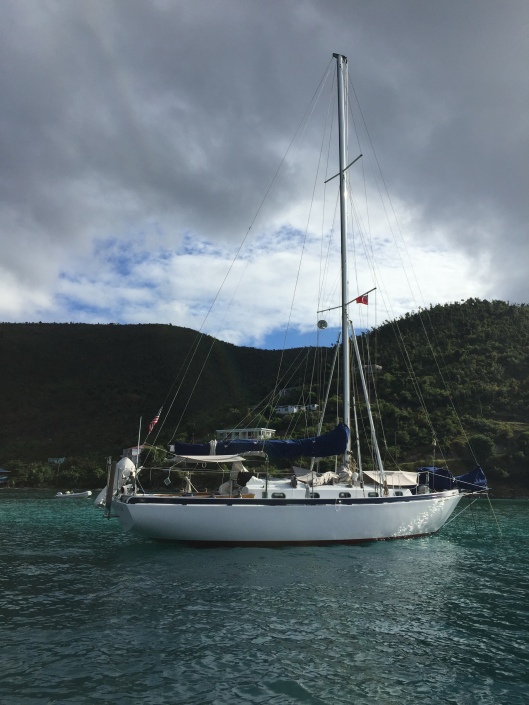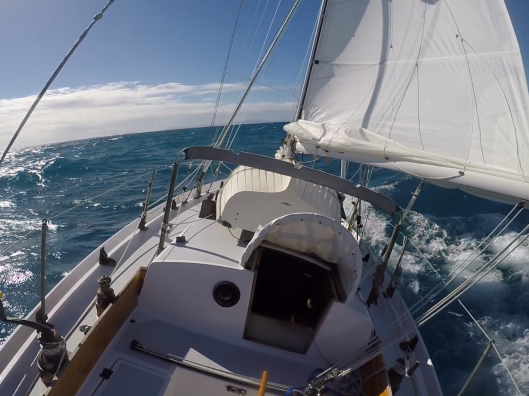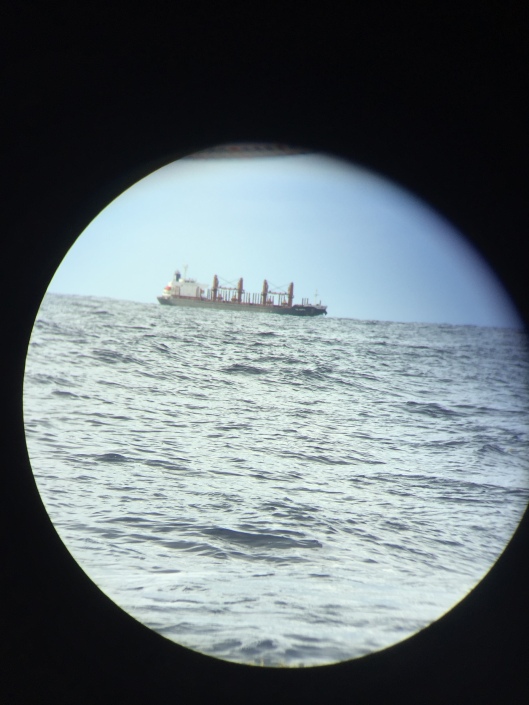
Anchored in 10’ of gin clear water on a sandy bottom in Great Harbor, Jost Van Dyke.
I departed Beaufort, NC on the heels of a low pressure system and after 12 days at sea made landfall across the north bank of the British Virgin Islands. I cleared in through customs at Great Harbor, Jost Van Dyke where I anchored in clear blue water on a sandy bottom.
This was a singlehanded passage marked mostly by strong but favorable winds. The pre-departure weather systems in eastern NC were rapidly degrading and the weather windows for a safe crossing of the Gulf Stream were getting smaller. I waited in Beaufort for about a week. Chris Parker, at Marine Weather Center, thought there would be an opening for a crossing on 3 December. This would be followed by a few days of light wind then a major US southeast coast winter storm was expect to roll-in with high winds, rain, and possibly snow.
I decided it was my best chance for reasonable sailing weather before we were too deep into the adverse winter weather patterns to be certain of clean break from the coast and across the Gulf Steam. We had about 18 hours to make final preparations but with Gayle’s indispensable help I was able to get underway at 0730 3 December.

Departing Town Creek on the Beaufort NC waterfront on the morning of 3 Dec 2018. The little 9.9 Honda got me to the turning basin where I shut her down and stowed her in the raised position, hoisted sails, and pointed the bow to the south east.
It turned out to be a fast passage…five days faster than last trip to the BVI in December 2015. I quickly got across the Gulf Stream and then had a day or two of downwind work at the beginning of the trip.

We wasted no time harnessing the southwest breeze and quickly got across the Gulf Stream in about 18 hours.
I worked hard to get as much offing as possible to avoid getting smashed by the soon to arrive winter storm that would ultimately pound the US east coast. The rest of the passage was upwind or reaching in a lot of wind. I was only becalmed twice for a total of maybe 20 hours. I had a couple 150 mile days and a bunch of 140 mile days. We were just tearing along.

The favorable winds allowed us to get south and east throughout the trip. We improved our time by five days over the last trip.
My course was more southeast than last time due to the better wind patterns. But, it was also a more bumpy ride.
I have to say the boat was just fantastic. She sailed great, upwind or downwind. Early in the trip we must have had 40 knots from the northwest. I was sailing downwind with only a double reefed stays’l! I was standing in the boat looking aft out of the companionway hatch over two drop boards at the building seas. A couple waves coming up from behind just took my breath away. They looked to be maybe 18-20’ but it’s hard to judge the size. The stern just rose and rose and rose and each time the waves slid right under us hissing as they passed by.

This is the smallest sail I had aboard the Far Reach—a double reefed stays’l. We were able to run downwind with it in 30kts with gusts to 40 kts. We were making better than 6 Knts.
We were never pooped (a wave washing over the stern and into the cockpit) during the voyage. There was of course lots of spray on deck and water from hull slap etc. Normal stuff. I had a couple tough days at the beginning due to a bad run in with the mal-de-mar then, fortunately, finally got my sealegs.

Film simple does not do justice to the power of the sea. There were some pretty big waves out there early in the trip. But, Carl Alberg, who designed the Far Reach, knew what he was doing. The boat was beautifully behaved throughout the voyage.
There was a lot of deck work and reefing and sail changes throughout the trip, necessary to keep the boat moving at her best pace. When the wind is up, night work on deck always creates some anxiety. I was careful and wore my harness and headlamp and moved with focus and deliberation. Still, hank-on head sails are a thorough test of your skill and confidence in offshore conditions.
We also had some light air sailing too. Make no mistake, sailing in light air on the open ocean can be very challenging and often frustrating. Even with our big sail plan the left over swells can shake the wind right out of the sails. There were a few times when I had to reduce sail way more than wind speed alone would otherwise dictate (or even drop the main to protect it from damaging slatting) due to the constant swell.

Some light air sailing after a night of being becalmed. The sea had laid down so we were making pretty good time in the light air…as long as there was no swell.
At night, as is the custom for most singlehanders, I reduced sail a bit more than the wind conditions required. Although it slowed my speed a bit, it was was important to buy a little freedom of action should the weather conditions deteriorate suddenly while I was asleep.

You know I was feeling better when I suddenly got hungry for a fat burger and potato slices cooked together in the skillet.
I was able to get reliable weather forecast from Chris Parker on my small Sony GR 7600 HF receiver. I sent him a lat/long via an inexpensive SPOT satellite one way message device each morning. He then transmitted a specific weather forecast for me “in the blind” over HF on 8137 MHz . It worked pretty well.
The last couple days saw us making some great progress towards the SSE. I briefly flirted with notion of slipping past Sombreo Light and into Sint Maarten via the Anegada Passage. But the trades suddenly shifted towards the ESE and increased to 30 Kts. It was going to require some serious beating and tacking and maybe a night hove-to to get to Sint Maarten. On the other hand, all I had to do was reach off and I’d be in the BVI as easy as could be. It was not a hard decision to make to slack off the sheets and alter course. As we say in the Marines: “It’s easy to be hard and hard to be smart…but if you’re stupid you better be hard.”

We crossed the north bank of the BVI on the morning of 15 December in 25-30 Kts of wind making over 7 Knts with a stays’l and a double reefed main.
Some statistics from the log book reveal:
⁃ I sailed 1,338 nautical miles in 12 days.
⁃ I reefed 11 times (reduced sail).
⁃ I made 21 sail changes (raised or lowered the sails).
⁃ I was becalmed twice for a total of about 20 hours. Both times at night.
⁃ I saw seven ships
⁃ I tacked five times and gybed three times.
Some interesting entries from the log:
-1230 5 Dec 18. “Cargo ships MV Atlantic Breeze, MV Giant Slotta, and SV Far Reach converge in Atlantic all with a CPA of 2.7nm. What are the odds?”

I took this photo with an iPhone through the lens of my binoculars. We saw seven ships this trip
-1610 5 Dec 18. “Wind increasing along with seas. Estimate wind gusting 40 kts. Double reefed stays’l only. Running nearly down wind.”
-2200 5 Dec 18. “Wind sounds furious. It’s pitch black outside. Occasional wind shifts. The Far Reach is attacking waves at different angles. Much leaping about. Some wave slapping. But inside is OK. Have not been pooped. Fell asleep in port pilot berth for 90 min. I would call this a gale.”
-2200 7 Dec 18. “Even though I tucked reef in mains’l at 2020 we are still tearing along making 7.2 – 8 kts! Dropped the traveler down to leeward. I may go to second reef. Course 132° M. I can tell the seas are bigger but not excessive. Heeling 15°-25°. A little more in the gusts. All sounds and motion are magnified at night.”
-2200 11 Dec 18. “Double reefed main and working jib. Excessive heeling and slamming. Tacked over without releasing jib sheet to backwind jib. Released jib halyard and jib dropped right down on fore-deck. Perfect. Secured jib with sail ties. Hoisted stays’l and resumed course of 100°M. Speed 5.5-6 Kts. Motion 10x better. Totally dark on deck. Scary. Exhausted but pleased by how well the sail change went. Who needs a jib furler! LOL.”
1900 12 Dec 18. [Becalmed. Not a breath of air. Position 23°16’N/62°29’W]. “AIS went off. A 39’ catamaran 1.3nm away on heading to cross our bow with CPA of less than 1/3 mile! I located the cat in the dark with the binos. Sails up. Engine running. Saloon lights on. Try to raise them on my handheld VHF radio. No response. Hit them with my spotlight. No reaction. They passed right on by and eventually disappeared into the dark. They are on a heading of about 125°M. Probably on way to BVI. We continue to roll in the calm while they speed away. Who needs an engine! LOL.”
-0700 15 Dec 18. “Land Ho! Spotted Virgin Gorda Peak at 190°M.”
-1445 15 Dec 18. “Anchored, Great Harbor, JVD, BVI.”
This was a good passage and an excellent test of my decision making and offshore sailing skills. I was pleased with the boat’s performance. I had her rigged well with multiple blocks for various sail configurations. I never had a “oh shit!” moment. We didn’t break anything. I didn’t get hurt. We made great time. I never doubted the boat or myself.
Although rewarding, an offshore voyage to the West Indies from the US mainland in December is not a delightful sail. While I would not call it grueling it is a dynamic,uncomfortable, and fatiguing passage, especially when singlehanding. It also has the potential to be damn scary if you are not on your game.
But man was it worth it! I am now anchored in 10’ of clear blue water on a white sand bottom on the east side of Great Harbor, Jost van Dyke. Sure, there are a lot of charter boats on the moorings and speeding dinghies but there is also plenty of sun, warm clear water, and lots of friendly smiles to go around for everyone.

Hanging out “on the hook.” With our dinghy Sweet Pea in the water I rigged a canvas “tent”” over the saloon hatch. Together with the jalousie window drop board we built before we left NC we have managed to keep good airflow in the boat regardless the weather.

I truly think this is your best sailing post ever! I learn something from you and your site everytime I read it.
We also are in transit on our 1982 CD 36 from CCTX to the Bahamas. Unfortunately our experience is limited so it’s slow with many stops; Grand Isle, LA, Venice, LA, Pensacola (family) due to weather and repairs.
But we’re meeting great people along the way and gaining knowledge.
It’s only my wife and I and the nights are looonnngg, wet and cold with many things to run into at night in the Gulf; shrimp boats, crew boats, pilot boats, big ships, little ships, oil rigs, abandoned oil rigs, unlit well heads, barges etc. we don’t have AIS yet but we do have radar and an auto pilot. The auto pilot works great until you cross a submarine cable, then it takes a hard right or left and follows the cable….. or just freaks out and makes little movements until I release it and handsteer out of the area. Unfortunately there’s a LOT sub cables.
How do you get enough sleep during a passage like that? We cat nap in the cockpit but the CD is such a wet boat we’re regularly getting wet and are zombies by Day 2. The weather and seas have been heavy with swells way over the height of the boat and then those errant waves that smack the boat and wash into the cockpit make for a tough time.
We’re headed to Tampa after Pensacola then to the Dry Tortugas before riding the stream to CatCay or Bimini.
We made our first youtube video; SV Mingus is the tag if you get a chance.
LikeLiked by 1 person
Hi Chuck. Thanks for the kind words. I’ve napped on the bridge deck in foulies but not too often. I stay below and set my timer for 20 min and do a thorough 360° scan then back down below.
I almost never hand steer…wind vane all the way. But, you are in a high traffic area and need to be extra vigilant. AIS is another tool. Not necessary when you have more than one person but helpful. We sailed to the BVI last time without it and had no issue. We ran a three hour watch, but only during the night. We had plenty of sleep.
By myself I rely on the AIS. I stay awake and scan constantly in the Gulf Stream or in high traffic areas. My AIS can transmit and I think it’s important to have that capability. Lots of folks have AIS but can’t or don’t transmit…fish boats don’t want the competition to know where they are. The CG and Navy don’t transmit. So I transmit whenever I’m sleeping. The rest of the time I am in receive only mode to save powers. Then, I scan every 20 min.
Keep at it. You’ll figure out what works for for you. See ya out there.
LikeLike
Hey Brother John, Loved reading about your passage and so relieved to know you made it there in one piece! What an incredible adventure and accomplishment! I cannot imagine All those days and long nights out On the open ocean on your own. Christmas Eve in Virginia and sending you my endless love and admiration! Wishing you a glorious Christmas Day in paradise,
Rae
LikeLiked by 1 person
Thanks sister. Love and miss ya. Merry Christmas.
LikeLike